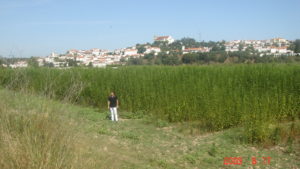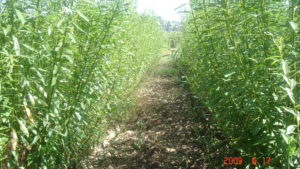Willow variety details – some updates
Since I wrote the SRC variety guide back in 2012 some new information has come to light. I always hoped that I would be commissioned to do a follow up but this hasn’t been the case. As people are always asking me about site specific information and different applications of the varieties I have decided to put the information together. I hope this is useful in helping you make a decision on what to plant.
Please note – most of the willow varieties we sell perform well in most sites. They have been tested in trials as far afield as in Bristol, Devon, Yorkshire, Hertfordshire, Nottinghamshire, Northern Ireland, Aberystywyth, Central Ireland and the Orkneys! In the information below we have noted potentially unsuitable sites e.g. if a variety struggles in drier situations.
You should look in the Variety Guide and the various papers I have written for yield information:
- Comparative trials of elite Swedish and UK biomass willow varieties
- Comparative trials of elite Swedish and UK biomass willow varieties 2001-2010
Bear in mind that yields are printed as oven dry tonnes (odt) per hectare. If you produce fuel yourself then you will need to dry it down to 20% moisture content. In order to calculate, the “boiler or stove ready” yield you should divide the odt figure by 0.8.
Terra Nova
This is by no means the highest yielding variety but it is the perfect all-rounder. Terra Nova has done well in altitude trials in west Wales (296 metres above sea level) and also in hot dry trials in Greece and Portugal. It is a branchy variety which is the earliest to flush (in February) and keeps its leaves into early December. The leafiness and late leaf fall is probably down to one of the parent species (Salix miyabeana) being of Chinese origin. Most Chinese willows such as Salix babylonica (weeping willow) and its many hybrids also have very long canopy duration. It therefore has potential application as part of windbreaks for horticulture crops, shelterbelts and for rearing poultry and other game birds. It is not as tall as other varieties. The branchiness makes it a good barrier to noise, smells, air pollution and should enable a greater hydraulic roughness, thereby making it a superior variety for reducing overland water flow. There is some evidence that this variety is less prone to damage by rabbits and deer so must have a more bitter taste than other willows. This resistance to vertebrates could also be down to the shininess of the leaves. There is also some evidence that genotypes with this parentage fair better in contaminated environments. The name Terra Nova means ‘new land’ and this willow has been effective in greening up problem sites such as restored landfill sites and sewage treatment works with heavy metal contamination (particularly Cadmium). Terra Nova has one of the highest calorific values (10% higher than Tora) which goes some way to compensating for it’s lower than average yield. It has no disease and is less prone to beetle damage than other varieties. It’s genetic background is very different from most available SRC varieties so this is an essential component of a mixed variety plantation as it will help reduce any spread of rust or beetles. I think you’ll probably realise that we like this variety a lot!
Endurance
I’ve already written extensively about this variety. See this blog.
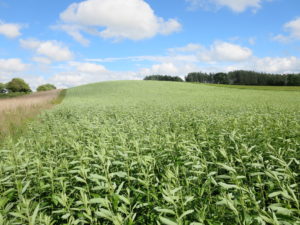
Endurance plantation . Note the dense foliage and large leaves right down to the ground level. This variety has a very different look to the others.
In the right place e.g. moist sites this willow is highly recommended for its very high yields, good woodfuel qualities and log like wood. It struggles in drier sites such as freely draining sites in East England and can be attacked by mites reducing its vigour. Like Terra Nova it has a Chinese parent species in its makeup (S. redheriana) and is very leafy and in trials has shown the longest canopy duration of any variety (297 days from late Feb to mid-December). As a result this variety is also perfect as part of windbreak or shelter belt project or for screening. It should also be good for flood mitigation and its high growth rate should make it an excellent candidate for inclusion in biofiltration plantations as it will take up lots of fluid for a long period of the year. Also, like Terra Nova there is recent evidence that this variety is favoured less by rabbits and deer. In this case the slight hairiness of the leaves may be the reason. There is some early indication that this variety has elevated levels of salicylic acid in its tissues. As a result this would be an excellent candidate for ramial woodchip (e.g. woodchip mulch in orchards to prevent apple scab disease).
Paramore
This is a female sibling of Endurance. It has many of the same characteristics but is less problematic on drier sites and doesn’t get infected by mites. It is slightly lower yielding than Endurance in most trials.
Endeavour
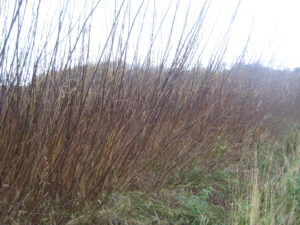
By the end of October Endeavour will have lost all its leaves. Its a wild but dense variety with conspicuously dark stems.
This variety is the earliest one to leaf up in the spring (usually buds burst at the end of January or early February) which is a few weeks earlier than the other varieties. It’s also the first variety to lose its leaves (in mid October). As a result it’s certainly useful as a windbreak for apple orchards in spring as it will have an earlier beneficial effect. It’s less beneficial as a screen or windbreak for winter protection but mixing with Endurance, Paramore and Terra Nova would give longer year round protection/ screening. It’s a little wild in its habit but has better woodfuel qualities (high dry matter, high bulk density and high calorific value) compared to other varieties. It should therefore season faster, take up less space and provide more heat. It has done particularly well in trials in the west of England and west Wales and produced good yields in altitude trials (228 metres above sea level). It tends to produce a much better second harvest yield compared to the first harvest. Recent research in Ireland has shown that Endeavour has the strongest wood of all current willow varieties. It had far higher values for Modulus of Rupture (MOR) and Modulus of Elasticity (MOE) than all other wilow varieties. The MOR is similar to other similar hardwood species (greater than poplar and red alder). This means that Endeavour could potentially be used for furniture production and is the only biomass variety with any degree of basket making potential.
Ref: SRC Willow in Furniture – An investigation into the properties and possible applications. Gabriel Hielscher BSc (Hons) Furniture Design and Manufacture Galway-Mayo Institute of Technology
Resolution

This is the 28 year old Kevin with 6 month old Resolution (planted as a 20 cm cutting in mid – March). Resolution had reached 3.85 metres in height! Note the lack of weed competition.
This is our star high yielding performer doing well in both wet and dry sites across the British Isles. Like many Swedish type varieties it is very tall, often reaching more than 3.5 metres in the first year (planting a 20cm cutting in mid March). It has a slight wave to its stems. This variety should be in any biomass planting and will also be perfect for biofiltration applications as its fast growth means that it will take up large quantities of fluid. Resolution has fewer shoots than other varieties. It therefore is possible to plant this as a tree or pollard (using a 2m long rod) as long as side shoots are rubbed out. It is untypical as a (S. viminalis x schwerinii hybrid in that it flushes early and also keeps its leaves later into the season (mid-November). It has very low incidence of rust and low to moderate susceptibility to beetles.
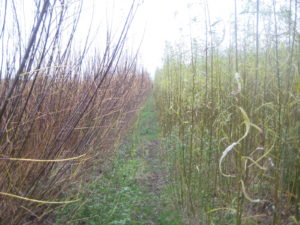
Meteor (on the right) has a bolt upright habit with few if any persistent side branches. (Thats Endeavour on the left which has a slightly more wild habit).
Meteor
This variety has the best form of any variety being very upright with lots of straight shoots. Although not particularly high yielding the rods could have many applications where straightness and virtually no side branching are important e.g. screening near roadways, around schools etc. Also, when harvested, the rods will require less processing for log production or other uses.
Beagle
Beagle is a really good Salix viminalis variety. It is not a very high yielder but is a perfect component of a mixed plantation. Its genetic background is quite different from many other varieties so it should be an effective barrier to spread of disease and pests. It tends to have many shoots per stool so will be good addition in a screening and shelterbelt application.
Advance
This is another good solid variety that has yielded well in most situations. I use this variety alot for gapping up.
If you wish to purchase cuttings please see our price list and contact us.
